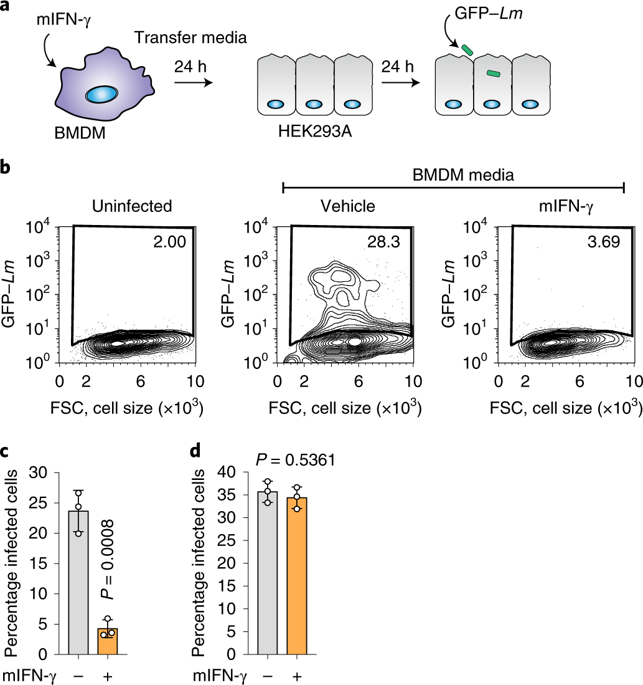Nature Microbiology ( IF 20.5 ) Pub Date : 2020-04-13 , DOI: 10.1038/s41564-020-0701-5 Michael E Abrams 1 , Kristen A Johnson 2 , Sofya S Perelman 1, 3 , Li-Shu Zhang 1 , Shreya Endapally 2 , Katrina B Mar 1 , Bonne M Thompson 2 , Jeffrey G McDonald 2 , John W Schoggins 1 , Arun Radhakrishnan 2 , Neal M Alto 1

|
Cholesterol 25-hydroxylase (CH25H) is an interferon-stimulated gene that converts cholesterol to the oxysterol 25-hydroxycholesterol (25HC). Circulating 25HC modulates essential immunological processes including antiviral immunity, inflammasome activation and antibody class switching; and dysregulation of CH25H may contribute to chronic inflammatory disease and cancer. Although 25HC is a potent regulator of cholesterol storage, uptake, efflux and biosynthesis, how these metabolic activities reprogram the immunological state of target cells remains poorly understood. Here, we used recently designed toxin-based biosensors that discriminate between distinct pools of plasma membrane cholesterol to elucidate how 25HC prevents Listeria monocytogenes from traversing the plasma membrane of infected host cells. The 25HC-mediated activation of acyl-CoA:cholesterol acyltransferase (ACAT) triggered rapid internalization of a biochemically defined fraction of cholesterol, termed ‘accessible’ cholesterol, from the plasma membrane while having little effect on cholesterol in complexes with sphingomyelin. We show that evolutionarily distinct bacterial species, L. monocytogenes and Shigella flexneri, exploit the accessible pool of cholesterol for infection and that acute mobilization of this pool by oxysterols confers immunity to these pathogens. The significance of this signal-mediated membrane remodelling pathway probably extends beyond host defence systems, as several other biologically active oxysterols also mobilize accessible cholesterol through an ACAT-dependent mechanism.
中文翻译:

氧甾醇通过动员细胞表面可接触的胆固醇来提供对细菌感染的先天免疫力。
胆固醇 25-羟化酶( CH25H ) 是一种干扰素刺激的基因,可将胆固醇转化为氧固醇 25-羟基胆固醇 (25HC)。循环中的 25HC 调节重要的免疫过程,包括抗病毒免疫、炎性体激活和抗体类别转换; CH25H失调可能导致慢性炎症性疾病和癌症。尽管 25HC 是胆固醇储存、摄取、流出和生物合成的有效调节剂,但这些代谢活动如何重新编程靶细胞的免疫状态仍知之甚少。在这里,我们使用最近设计的基于毒素的生物传感器来区分不同的质膜胆固醇池,以阐明 25HC 如何阻止单核细胞增生李斯特氏菌穿过受感染宿主细胞的质膜。 25HC 介导的酰基辅酶 A:胆固醇酰基转移酶 (ACAT) 的激活触发了生化定义的胆固醇部分(称为“可接近”胆固醇)从质膜快速内化,同时对与鞘磷脂复合物中的胆固醇几乎没有影响。我们表明,进化上不同的细菌种类,单核细胞增生李斯特氏菌和福氏志贺氏菌,利用可利用的胆固醇池进行感染,并且氧化甾醇对该池的急性动员赋予了对这些病原体的免疫力。这种信号介导的膜重塑途径的重要性可能超出了宿主防御系统的范围,因为其他几种具有生物活性的氧甾醇也通过 ACAT 依赖性机制动员可利用的胆固醇。











































 京公网安备 11010802027423号
京公网安备 11010802027423号